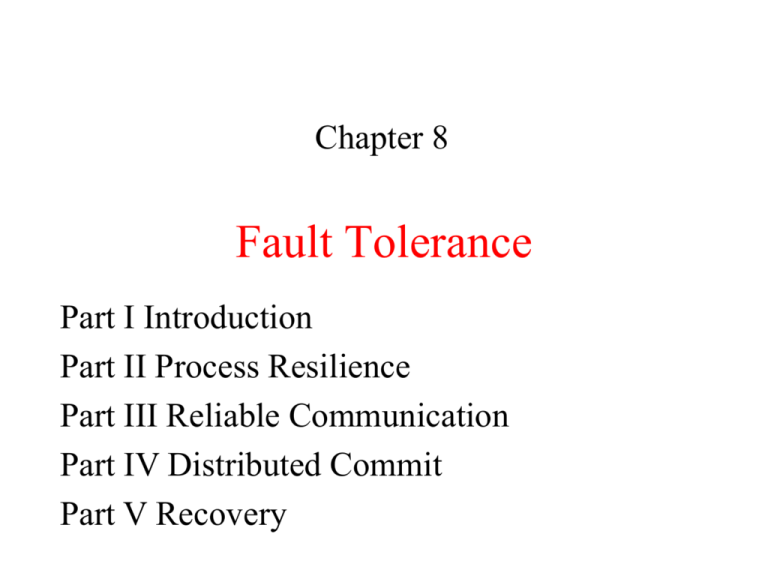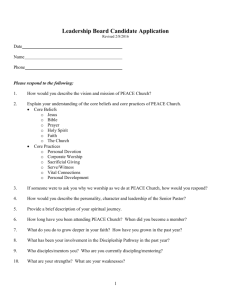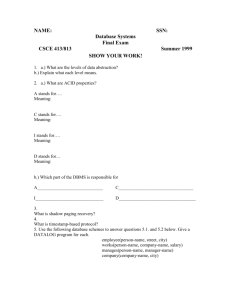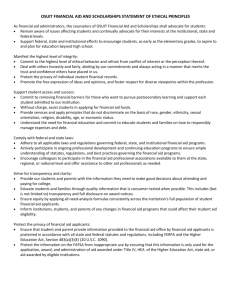Fault Tolerance
advertisement

Chapter 8
Fault Tolerance
Part I Introduction
Part II Process Resilience
Part III Reliable Communication
Part IV Distributed Commit
Part V Recovery
CSCE455/855 Distributed Operating Systems
Giving credit where credit is due:
Most of the lecture notes are based on slides by Prof. Jalal Y.
Kawash at Univ. of Calgary and Dr. Daniel M. Zimmerman at
CALTECH
Some of the lecture notes are based on slides by Scott
Shenker and Ion Stoica at Univ.of California, Berkeley, Timo
Alanko at Univ. of Helsinki, Finland, Hugh C. Lauer at
Worcester Polytechnic Institute, Xiuwen Liu at Florida State
University
I have modified them and added new slides
Chapter 8
Fault Tolerance
Part I
Introduction
Fault Tolerance
• A DS should be fault-tolerant
– Should be able to continue functioning in the
presence of faults
• Fault tolerance is related to dependability
Dependability
Dependability Includes
•
•
•
•
Availability
Reliability
Safety
Maintainability
Availability & Reliability (1)
• Availability: A measurement of whether a system
is ready to be used immediately
– System is up and running at any given moment
• Reliability: A measurement of whether a system
can run continuously without failure
– System continues to function for a long period of time
Availability & Reliability (2)
• A system goes down 1ms/hr has an
availability of more than 99.99%, but is
unreliable
• A system that never crashes but is shut
down for a week once every year is 100%
reliable but only 98% available
Safety & Maintainability
• Safety: A measurement of how safe failures are
– System fails, nothing serious happens
– For instance, high degree of safety is required for
systems controlling nuclear power plants
• Maintainability: A measurement of how easy
it is to repair a system
– A highly maintainable system may also show a high
degree of availability
– Failures can be detected and repaired automatically?
Self-healing systems?
Faults
• A system fails when it cannot meet its promises
(specifications)
• An error is part of a system state that may lead to a
failure
• A fault is the cause of the error
• Fault-Tolerance: the system can provide services
even in the presence of faults
• Faults can be:
– Transient (appear once and disappear)
– Intermittent (appear-disappear-reappear behavior)
• A loose contact on a connector intermittent fault
– Permanent (appear and persist until repaired)
Failure Models
Type of failure
Description
Crash failure
A server halts, but is working correctly until it halts
Omission failure
Receive omission
Send omission
A server fails to respond to incoming requests
A server fails to receive incoming messages
A server fails to send messages
Timing failure
A server's response lies outside the specified time interval
Response failure
Value failure
State transition failure
The server's response is incorrect
The value of the response is wrong
The server deviates from the correct flow of control
Arbitrary failure
(Byzantine failure)
A server may produce arbitrary responses at arbitrary times
Failure Masking
?
• Redundancy is key technique for hiding failures
• Redundancy types:
1. Information: add extra (control) information
•
Error-correction codes in messages
2. Time: perform an action persistently until it
succeeds:
•
Transactions
3. Physical: add extra components (S/W & H/W)
•
Process replication, electronic circuits
Example – Redundancy in Circuits (1)
Example – Redundancy in Circuits (2)
Triple modular redundancy.
Chapter 8
Fault Tolerance
Part II
Process Resilience
Process Resilience
• Mask process failures by replication
• Organize processes into groups, a message sent
to a group is delivered to all members
• If a member fails, another should fill in
Flat Groups versus Hierarchical Groups
a)
b)
Communication in a flat group.
Communication in a simple hierarchical group
Process Replication
• Replicate a process and group replicas in one group
• How many replicas do we create?
• A system is k fault-tolerant if it can survive and
function even if it has k faulty processes
– For crash failures (a faulty process halts, but is working
correctly until it halts)
• k+1 replicas
– For Byzantine failures (a faulty process may produce
arbitrary responses at arbitrary times)
• 2k+1 replicas
Agreement
• Need agreement in DS:
– Leader, commit, synchronize
• Distributed Agreement algorithm: all nonfaulty processes achieve consensus in a finite
number of steps
• Perfect processes, faulty channels: two-army
• Faulty processes, perfect channels: Byzantine
generals
Two-Army Problem
Byzantine Generals Problem
Byzantine Generals -Example (1)
The Byzantine generals problem for 3 loyal generals and1 traitor.
a)
The generals announce the time to launch the attack (by messages
marked by their ids).
b)
The vectors that each general assembles based on (a)
c)
The vectors that each general receives in step 3, where every general
passes his vector from (b) to every other general.
Byzantine Generals –Example (2)
The same as in previous slide, except now
with 2 loyal generals and one traitor.
Byzantine Generals
• Given three processes, if one fails, consensus is
impossible
• Given N processes, if F processes fail,
consensus is impossible if N 3F
OceanStore
Global-Scale Persistent Storage on
Untrusted Infrastructure
Update Model
• Concurrent updates w/o wide-area locking
– Conflict resolution
• Updates Serialization
• A master replica?
– Incompatible with the untrusted infrastructure assumption
• Role of primary tier of replicas
– All updates submitted to primary tier of replicas which
chooses a final total order by following Byzantine agreement
protocol
• A secondary tier of replicas
– the result of the updates is multicast down the dissemination
tree to all the secondary replicas
The Path of an
OceanStore Update
Chapter 8
Fault Tolerance
Part III
Reliable Communication
Reliable Group
Communication
Reliable Group Communication
• When a group is static and processes do not fail
• Reliable communication = deliver the message
to all group members
– Any order delivery
– Ordered delivery
Basic Reliable-Multicasting Schemes
A simple solution to reliable multicasting when all
receivers are known and assumed not to fail
a) Message transmission
b) Reporting feedback
Atomic Multicast
• All messages are delivered in the same order to “all” processes
• Group view: the view on the set of processes contained in the
group
• Virtual synchronous multicast: a message m multicast to a
group view G is delivered to all non-faulty processes in G
Virtual Synchrony System Model
The logical organization of a distributed system to distinguish
between message receipt and message delivery
Message Delivery
Delivery of messages
- new message => HBQ
- decision making
- delivery order
- deliver or not to deliver?
- the message is allowed to be
delivered: HBQ => DQ
- when at the head of DQ:
message => application
(application: receive …)
Application
delivery
hold-back queue
delivery queue
Message passing system
Virtual Synchronous Multicast
a) Message is not
delivered
b) Message is
delivered
A
A
B
B
C
C
Gi = (A, B, C)
Gi+1 = (B, C)
Gi = (A, B, C)
Gi+1 = (B, C)
Virtual Synchronous Multicast
a) Message is not
delivered
b) ???
A
A
B
B
C
C
Gi = (A, B, C)
Gi+1 = (B, C)
Gi = (A, B, C)
Gi+1 = (B, C)
Virtual Synchronous Multicast
a) ???
A
B
C
Gi = (A, B, C)
Gi+1 = (B, C)
Reliability of Group Communication?
• A sent message is received by all members
(acks from all => ok)
• Problem: during a multicast operation
– an old member disappears from the group
– a new member joins the group
• Solution
– membership changes synchronize multicasting
during a MC operation no membership changes
– Virtual synchrony: “all” processes see message and membership
change in the same order
Virtual Synchronous Multicast
a) Message is not
delivered
b) Message is
delivered
A
A
B
B
C
C
Gi = (A, B, C)
Gi+1 = (B, C)
Gi = (A, B, C)
Gi+1 = (B, C)
Virtual Synchrony Implementation:
[Birman et al., 1991]
• Only stable messages are delivered
• Stable message: a message received by all processes in
the message’s group view
• Assumptions (can be ensured by using TCP):
– Point-to-point communication is reliable
– Point-to-point communication ensures FIFO-ordering
• How to determine if a message is stable?
Virtual Synchrony Implementation:
Example
•
•
•
•
Gi = {P1, P2, P3, P4, P5}
P5 fails
P1 detects that P5 has failed
P1 send a “view change” message
to every process in Gi+1 = {P1, P2,
P3, P4}
P1
P2
P3
change view
P4
P5
Virtual Synchrony Implementation:
Example
• Every process
– Send each unstable message
m from Gi to members in Gi+1
– Marks m as being stable
– Send a flush message to mark
that all unstable messages
have been sent
unstable message
P2
P3
P1
P4
P5
flush
message
Virtual Synchrony Implementation:
Example
Every process
– After receiving a flush message
from all processes in Gi+1 installs
Gi+1
P2
P3
P1
P4
P5
Announcement
• 2nd Midterm in the week after Spring Break
– March 27, Wednesday
• Chapters 6, 7, 8.1, & 8.2
Distributed Commit
• Goal: Either all members of a group decide to
perform an operation, or none of them perform
the operation
• Atomic transaction: a transaction that happens
completely or not at all
Assumptions
• Failures:
– Crash failures that can be recovered
– Communication failures detectable by timeouts
• Notes:
– Commit requires a set of processes to agree…
– …similar to the Byzantine generals problem…
– … but the solution much simpler because stronger
assumptions
Distributed Transactions
client
Atomic
atomic
Consistent
isolated
Isolated
serializable
Durable
server
Database
server
server
client
Database
A Distributed Banking Transaction
join
openTransaction
closeTransaction
participant
A
.
a.withdraw(4);
join
BranchX
T
participant
Client
T = openTransaction
a.withdraw(4);
c.deposit(4);
b.withdraw(3);
d.deposit(3);
closeTransaction
B
join
b.withdraw(3);
BranchY
participant
C
c.deposit(4);
D
d.deposit(3);
BranchZ
One-phase Commit
• One-phase commit protocol
– One site is designated as a coordinator
– The coordinator tells all the other processes whether
or not to locally perform the operation in question
– This scheme however is not fault tolerant
Transaction Processing (1)
S1
F1
T_Id
coordinator
client
….
Open transaction
T_write F1,P1
T_write F2,P2
T_write F3,P3
Close transaction
….
flag: init
P1
27
join
F2
S2
T_Id
flag: init
participant
S3
P2
F3
T_Id
participant
flag: init
P3
2745
27
Transaction Processing (2)
Close
client
….
Open transaction
T_read F1,P1
T_write F2,P2
T_write F3,P3
Close transaction
….
F1
coordinator
T_Id
init
committed
wait
done
doCommit !
canCommit?
P1
Yes
HaveCommitted
27
T_Id
committed
ready
init
P2
Yes
HaveCommitted
T_Id
committed
ready
init
P3
2745
27
Two Phase Commit (2PC)
Coordinator
Participants
send VOTE_REQ to all
send vote to coordinator
if (vote == no)
decide abort
halt
if (all votes yes)
decide commit
send COMMIT to all
else
decide abort
send ABORT to all who voted yes
halt
if receive ABORT, decide abort
else decide commit
halt
Two-Phase Commit (1)
✗
a)
b)
The finite state machine for the coordinator in 2PC.
The finite state machine for a participant.
Two-Phase Commit (2)
✗
a)
b)
The finite state machine for the coordinator in 2PC.
The finite state machine for a participant.
Two-Phase Commit (3)
State of Q
Action by P
COMMIT
Make transition to COMMIT
ABORT
Make transition to ABORT
INIT
Make transition to ABORT
READY
Contact another participant
Actions taken by a participant P when residing in state
READY and having contacted another participant Q.
Two-Phase Commit (4)
actions by coordinator:
write START _2PC to local log;
multicast VOTE_REQUEST to all participants;
while not all votes have been collected {
wait for any incoming vote;
if timeout {
write GLOBAL_ABORT to local log;
multicast GLOBAL_ABORT to all participants;
exit;
}
record vote;
}
if all participants sent VOTE_COMMIT and coordinator votes COMMIT{
write GLOBAL_COMMIT to local log;
multicast GLOBAL_COMMIT to all participants;
} else {
write GLOBAL_ABORT to local log;
multicast GLOBAL_ABORT to all participants;
}
Outline of the steps taken by the coordinator in 2PC.
Two-Phase Commit (5)
actions by participant:
Steps taken by
participant
process in
2PC.
write INIT to local log;
wait for VOTE_REQUEST from coordinator;
if timeout {
write VOTE_ABORT to local log;
exit;
}
if participant votes COMMIT {
write VOTE_COMMIT to local log;
send VOTE_COMMIT to coordinator;
wait for DECISION from coordinator;
if timeout {
multicast DECISION_REQUEST to other participants;
wait until DECISION is received; /* remain blocked */
write DECISION to local log;
}
if DECISION == GLOBAL_COMMIT
write GLOBAL_COMMIT to local log;
else if DECISION == GLOBAL_ABORT
write GLOBAL_ABORT to local log;
} else {
write VOTE_ABORT to local log;
send VOTE ABORT to coordinator;
}
Two-Phase Commit (6)
actions for handling decision requests: /* executed by separate thread */
while true {
wait until any incoming DECISION_REQUEST is received; /* remain blocked */
read most recently recorded STATE from the local log;
if STATE == GLOBAL_COMMIT
send GLOBAL_COMMIT to requesting participant;
else if STATE == INIT or STATE == GLOBAL_ABORT
send GLOBAL_ABORT to requesting participant;
else
skip; /* participant remains blocked */
Steps taken by participant process for handling incoming
decision requests.
Two-Phase Commit(7)
• When all participants are in the ready states,
no final decision can be reached
• Two-phase commit is a blocking commit
protocol
Three-Phase Commit (1)
• There is no state from which a transition can be
made to either Commit or Abort
• There is no state where it is not possible to make a
final decision and from which transition can be
made to Commit
• non-blocking commit protocol
Three-Phase Commit (2)
• Coordinator sends Vote_Request (as before)
• If all participants respond affirmatively,
• Put Precommit state into log on stable storage
• Send out Prepare_to_Commit message to all
• After all participants acknowledge,
• Put Commit state in log
• Send out Global_Commit
Three-Phase Commit (3)
• Coordinator blocked in Wait state
• Safe to abort transaction
• Coordinator blocked in Precommit state
• Safe to issue Global_Commit
• Any crashed or partitioned participants will commit when
recovered
Three-Phase Commit (4)
• Participant blocked in Precommit state
• Contact others
• Collectively decide to commit
• Participant blocked in Ready state
•
•
•
•
Contact others
If any in Abort, then abort transaction
If any in Precommit, the move to Precommit state
If all in Ready state, then abort transaction
Chapter 8
Fault Tolerance
Part V
Recovery
Recovery
We’ve talked a lot about fault tolerance, but
not about what happens after a fault has
occurred
A process that exhibits a failure has to be able
to recover to a correct state
There are two basic types of recovery:
Backward Recovery
Forward Recovery
Backward Recovery
The goal of backward recovery is to bring the
system from an erroneous state back to a prior
correct state
The state of the system must be recorded checkpointed - from time to time, and then
restored when things go wrong
Examples
Reliable communication through packet
retransmission
Forward Recovery
The goal of forward recovery is to bring a
system from an erroneous state to a correct
new state (not a previous state)
Examples:
Reliable communication via erasure correction,
such as an (n, k) block erasure code
More on Backward Recovery
Backward recovery is far more widely applied
The goal of backward recovery is to bring the
system from an erroneous state back to a prior
correct state
But, how to get a prior correct state?
-
-
Checkpointing
Checkpointing is costly, so it’s often combined
with message logging
Stable Storage
In order to store checkpoints and logs,
information needs to be stored safely - not just
able to survive crashes, but also able to survive
hardware faults
RAID is the typical example of stable storage
Checkpointing
Related to checkpointing, let us first discuss
the global state and the distributed snapshot
algorithm
Determining Global States
The global state of a distributed computation is
the set of local states of all individual processes
involved in the computation
+
the states of the communication channels
How?
Obvious First Solution…
•
Synchronize clocks of all processes and ask all
processes to record their states at known time t
•
Problems?
Time synchronization possible only approximately
distributed
banking applications: no approximations!
Does not record the state of messages in the channels
Global State
We cannot determine the exact global state
of the system, but we can record a
snapshot of it
Distributed Snapshot: a state the system
might have been in [Chandy and Lamport]
A naïve snapshot algorithm
Processes record their states at any arbitrary points
A designated process collects these states
+ So simple!!
- Correct??
Example
Producer Consumer problem
p
m
p records its state
q
Example
p
q
m
Example
p
q
m
q records its state
Example
The recorded state
p
q
m
m
The sender has no record of the sending
The receiver has the record of the receipt
What’s Wrong?
p
m
q
Result:
Global state has record of the receive event but no
send event violating the happens-before concept!!
Cut
A consistent cut (meaningful global state) ?
Cut
A consistent cut (meaningful global state) ?
Cuts
a)
b)
A consistent cut (meaningful global state)
An inconsistent cut
The “Snapshot” Algorithm
Records a set of process and channel
states such that the combination is a
consistent GS.
Assumptions:
All messages arrive intact, exactly once
Communication channels are unidirectional and FIFOordered
There is a comm. path between any two processes
Any process may initiate the snapshot (sends Marker)
Snapshot does not interfere with normal execution
Each process records its state and the state of its
incoming channels
The “Snapshot” Algorithm (2)
1. Marker sending rule for initiator process P0
After P0 has recorded its state
• for each outgoing channel C, sends a marker on C
2. Marker receiving rule for a process Pk, on receipt
of a marker over channel C
if Pk has not yet recorded its state
- records Pk’s state
- records the state of C as “empty”
- turns on recording of messages over other incoming
channels
• for each outgoing channel C, sends a marker on C
- else
- records the state of C as all the messages received over C
since Pk saved its state
Snapshot Example
P1
e10
e11,2
M
a
P2
e13 e14
M
M
e20 e 1,2,3
2
b
P3
e30
e15
e24 e25
M
M M
e31,2,3
e34
1- P1 initiates snapshot: records its state (S1); sends Markers to P2 & P3;
turns on recording for channels C21 and C31
2- P2 receives Marker over C12, records its state (S2), sets state(C12) = {}
sends Marker to P1 & P3; turns on recording for channel C32
3- P1 receives Marker over C21, sets state(C21) = {a}
4- P3 receives Marker over C13, records its state (S3), sets state(C13) = {}
sends Marker to P1 & P2; turns on recording for channel C23
5- P2 receives Marker over C32, sets state(C32) = {b}
6- P3 receives Marker over C23, sets state(C23) = {}
7- P1 receives Marker over C31, sets state(C31) = {}
Snapshot Example
P1
e10
e13
a
P2
e24
e20
b
P3
e30
Distributed Snapshot Algorithm
When a process finishes local snapshot, it
collects its local state (S and C) and sends
it to the initiator of the distributed snapshot
The initiator can then analyze the state
One algorithm for distributed global
snapshots, but it’s not particularly efficient
for large systems
Checkpointing
We’ve discussed distributed snapshots
The most recent distributed snapshot in a
system is also called the recovery line
Independent Checkpointing
It is often difficult to find a recovery line in a
system where every process just records its
local state every so often - a domino effect or
cascading rollback can result:
Coordinated Checkpointing
To solve this problem, systems can implement
coordinated checkpointing
We’ve discussed one algorithm for distributed
global snapshots, but it’s not particularly
efficient for large systems
Another way to do it is to use a two-phase
blocking protocol (with some coordinator) to
get every process to checkpoint its local state
“simultaneously”
Coordinated Checkpointing
Make sure that processes are synchronized when
doing the checkpoint
Two-phase blocking protocol
Coordinator multicasts CHECKPOINT_REQUEST
Processes take local checkpoint
Delay further sends
Acknowledge to coordinator
Send state
3.
Coordinator multicasts CHECKPOINT_DONE
1.
2.
Message Logging
Checkpointing is expensive - message logging
allows the occurrences between checkpoints to
be replayed, so that checkpoints don’t need to
happen as frequently
Message Logging
We need to choose when to log messages
Message-logging schemes can be
characterized as pessimistic or optimistic by
how they deal with orphan processes
An orphan process is one that survives the crash of
another process but has an inconsistent state after
the other process recovers
Message Logging
An example of an incorrect replay of messages
Message Logging
We assume that each message m has a header
containing all the information necessary to
retransmit m (sender, receiver, sequence no., etc.)
A message is called stable if it can no longer be lost
- a stable message can be used for recovery by
replaying its transmission
Message Logging
Each message m leads to a set of dependent
processes DEP(m), to which either m or a message
causally dependent on m has been delivered
Message Logging
The set COPY(m) consists of the processes that have
a copy of m, but not in their local stable storage any process in COPY(m) could deliver a copy of m
on request
Message Logging
Process Q is an orphan process if there is a nonstable
message m, such that Q is contained in DEP(m), and
every process in COPY(m) has crashed
Message Logging
To avoid orphan processes, we need to ensure that if
all processes in COPY(m) crash, no processes
remain in DEP(m)
Pessimistic Logging
For each nonstable message m, ensure that at
most one process P is dependent on m
The worst that can happen is that P crashes
without m ever having been logged
No other process can have become dependent
on m, because m was nonstable, so this leaves
no orphans
Optimistic Logging
The work is done after a crash occurs, not before
If, for some m, each process in COPY(m) has
crashed, then any orphan process in DEP(m)
gets rolled back to a state in which it no longer
belongs in DEP(m)
Optimistic Logging
The work is done after a crash occurs, not before
If, for some m, each process in COPY(m) has
crashed, then any orphan process in DEP(m)
gets rolled back to a state in which it no longer
belongs in DEP(m)
Dependencies need to be explicitly tracked,
which makes this difficult to implement - as a
result, pessimistic approaches are preferred in
real-world implementations








